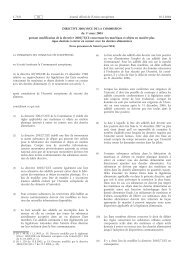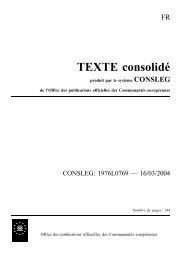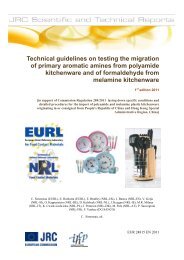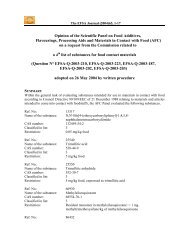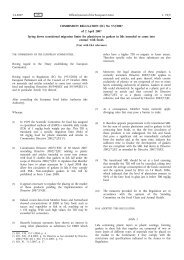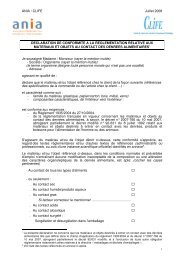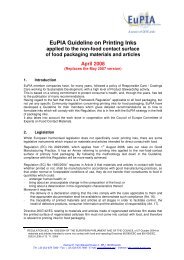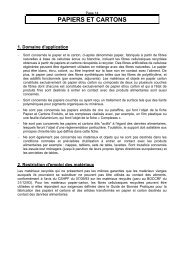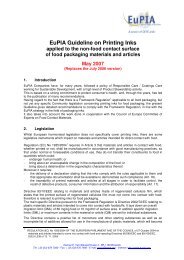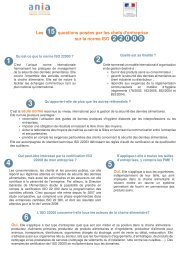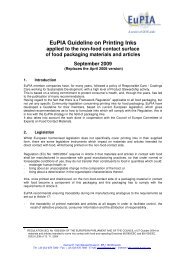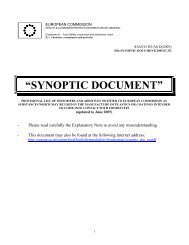List 1 - Contact alimentaire
List 1 - Contact alimentaire
List 1 - Contact alimentaire
- No tags were found...
You also want an ePaper? Increase the reach of your titles
YUMPU automatically turns print PDFs into web optimized ePapers that Google loves.
The EFSA Journal (2007) 555-563, 1-32Scientific Opinion of the Panel on food additives, flavourings, processing aidsand materials in contact with food (AFC) on a requestrelated toa 16 th list of substances for food contact materialsQuestion N° EFSA-Q-2005-153,EFSA-Q-2003-180, EFSA-Q-2007-083, EFSA-Q-2007-010, EFSA-Q-2005-284,EFSA-Q-2004-101, EFSA-Q-2007-005, EFSA-Q-2007-011, EFSA-Q-2007-003Adopted on 25-26 September 2007SCIENTIFIC PANEL MEMBERSFernando Aguilar, Herman Autrup, Sue Barlow, Laurence Castle, Riccardo Crebelli, WolfgangDekant*, Karl-Heinz Engel, Nathalie Gontard, David Gott, Sandro Grilli*, Rainer Gürtler, JohnChristian Larsen, Jean-Charles Leblanc, Catherine Leclercq, François Xavier Malcata, WimMennes, Maria Rosaria Milana, Iona Pratt, Ivonne Rietjens, Paul Tobback, Fidel Toldrá.SUMMARYWithin the general task of evaluating substances intended for use in materials in contact with foodaccording to the Regulation (EC) No.1935/2004 of the European Parliament and of the Council of27 October 2004 on materials and articles intended to come into contact with foodstuffs, the AFCPanel evaluated the following substances:Ref. No.: 34130Name of the substance: Alkyl, linear with even number of carbon atoms (C12-C20)dimethylaminesCAS number: -Classified in list: 2Restriction:TDI = 0.5 mg/kg bwRef. No.: 37520Name of the substance: 1,2-Benzisothiazolin-3-oneCAS number: 002634-33-5© European Food Safety Authority, 2007
16 th list of FCM substancesAgCl: 007783-90-6Classified in list: 3Restriction:Group restriction of 0.05 mg Ag/kg foodKEYWORDSFood <strong>Contact</strong> Materials, Plastics, Monomers, Additives, REF. No 34130, Alkyl, linear with evennumber of carbon atoms (C12-C20) dimethylamines, REF. No 37520, CAS No. 002634-33-5, 1,2-Benzisothiazolin-3-one, REF. No 39815, CAS No. 182121-12-6, 9,9-Bis(methoxymethyl)fluorene,REF. No 45703, CAS No. 491589-22-1, cis-1,2-Cyclohexanedicarboxylic acid, calcium salt, REF.No 66755, CAS No. 2682-20-4, 2-Methyl-4-isothiazolin-3-one, REF. No 76463, CAS No. 9003-04-7, Polyacrylic acid, sodium salt, REF. No 76723, CAS. No 167883-16-1, Polydimethylsiloxane,3-aminopropyl terminated, polymer with dicyclohexylmethane- 4,4’-diisocyanate, REF No 76725,CAS. No 661476-41-1, Polydimethylsiloxane, 3-aminopropyl terminated, polymer with 1-isocyanato-3-isocyanatomethyl-3,5,5-trimethylcyclohexane, REF. No 86430, CAS No. TiO 2 :013463-67-7, AgCl: 007783-90-6, Silver chloride (20% w/w) coated onto titanium dioxide (80%w/w).BACKGROUNDBefore a substance is authorised to be used in food contact materials and is included in a positivelist EFSA´s opinion on its safety is required. This procedure has been established in Articles 8 and9 of the Regulation (EC) No. 1935/2004 of the European Parliament and of the Council of 27October 2004 on materials and articles intended to come into contact with food 1 .TERMS OF REFERENCEThe EFSA is required by Article 10 of Regulation (EC) No. 1935/2004 of the European Parliamentand of the Council on materials and articles intended to come into contact with food to carry outrisk assessments on the risks originating from the migration of substances from food contactmaterials into food and deliver a scientific opinion on:1. new substances intended to be used in food contact materials before their authorisation andinclusion in a positive list;2. substances which are already authorised in the framework of Regulation (EC) No.1935/2004 but need to be re-evaluated.1 This Regulation replaces Directive 89/109/EEC of 21 December 1988, OJ L 40, 11.2.1989, P.38The EFSA Journal (2007) 555-563, 3-32
16 th list of FCM substancesACKNOWLEDGEMENTSThe European Food Safety Authority wishes to thank Herman Autrup, Mona-Lise Binderup,Laurence Castle, Riccardo Crebelli, Wolfgang Dekant, Nathalie Gontard, Roland Franz, EugeniaLampi, Jean-Claude Lhuguenot, François Xavier Malcata, Maria Rosaria Milana, A. Mortensen,Bevan Moseley, A. K. Müller, C. Nellemann, Karla Pfaff, S Rossi, T.G. Siere, A.A.M. Stolker,Paul Tobback, Detlef Wölfle and Esther Zondervan-van den Beuken*, for their contribution to thedraft opinion.* Wolfgang Dekant, member of the Panel, declared an interest for the substances REF. No. 76723 and 76725 andtherefore he did not participate in the discussion on these substances.Sandro Grilli, member of the Panel, declared an interest for the substance REF. No. 66755, 2-Methyl-4-isothiazolin-3-one and therefore he did not participate in the discussion on this substance.Esther Zondervan-van den Beuken, expert of the working group declared an interest for the substance REF. No.39815, 9,9-Bis(methoxymethyl)fluorene, and therefore she did not participate in the discussion on this substance inthe working group.Details on the declarations of interest can be found in the minutes of the Panel meeting at:http://www.efsa.europa.eu/EFSA/ScientificPanels/AFC/efsa_locale-1178620753812_Meetings424.htmThe EFSA Journal (2007) 555-563, 4-32
16 th list of FCM substancesASSESSMENTWithin this general task the Scientific Panel on food additives, flavourings, processing aidsand materials in contact with food (AFC) evaluated the following substances used in foodcontact materials.The substances examined are listed in ascending order of their Reference Number (REF No.),with their chemical name, Chemical Abstract Number (CAS No.) and classificationaccording to the “SCF list”. (Since in the past the evaluation of substances used in foodcontact materials was undertaken by the Scientific Committee on Food (SCF), the samesystem of classification into a “SCF list” is retained for uniformity purposes). The definitionsof the various SCF lists and the abbreviations used are given in the appendix.The studies submitted for evaluation followed the SCF guidelines for the presentation of anapplication for safety assessment of a substance to be used in food contact materials prior toits authorisation (http://ec.europa.eu/food/fs/sc/scf/out82_en.pdf)Ref. No.: 34130Name of the substance:Alkyl, linear with even number of carbon atoms (C12-C20)dimethylaminesCAS number:Document reference: SDS EFSA/AFC/FCM/1021-Rev.0A/34130 (ex 34045) of May 2007General information:Previous evaluations (bySCF or AFC):According to the petitioner, alkyl, linear with even number ofcarbon atoms (C12-C20) dimethylamines are intended to be used asdetergents, dying auxiliaries, wetting agents and antistatic agents inplastics intended to come into contact with all types of foodstuffs.Maximum percentage in formulation is 0.01% w/w.None (new substance)Available dataused for this evaluation:Non-toxicity data: - Data on identity- Data on physical and chemical properties- Data on use and authorisation- Data on migration- Data on residual content of the substanceToxicity data - Gene mutation in bacteria- In vitro chromosomal aberrations in cultured mammalian cells- In vitro gene mutation in cultured mammalian cells- Conclusions on chronic toxicity based on results of 2 year oralThe EFSA Journal (2007) 555-563, 5-32
16 th list of FCM substancesRef. No.: 34130Name of the substance: Alkyl, linear with even number of carbon atoms (C12-C20)dimethylaminesConclusion:Based on the above-mentioned data the substance is classified:SCF_<strong>List</strong>: 2Restriction: TDI = 0.5 mg/kg bwRemark for Commission: NoneNeeded data or NoneinformationReferences: - Unpublished data submitted by the petitioner on 30-01-2007- Turan, T.S, Gibson, W.B. A comparison of the elimination andbiotransformation of dodecyldimethylamine oxide (DDAO) byrats, rabbits and man. Xenobiotica, vol. 11, 447-458 (1981).- Rice, D.P. The absorption, tissue distribution and excretion ofdodecyldimethylamine oxide (DDAO) in selected animalspecies and the absorption and excretion of DDAO in man.Toxicol. Appl. Pharmacol. vol. 39, 377-389 (1977).- Cardin, C.W., Domeyer, B.E., Bjorkquist, L. Toxicologicalevaluation of commercial alkyldimethylamine oxides: two-yearchronic feeding and dermal studies. Fund. Appl. Toxicol. vol. 5,869-878 (1985).Ref. No.: 37520Name of the substance: 1,2-Benzisothiazolin-3-oneCAS number: 002634-33-5Document reference: SDS EFSA/AFC/FCM 605-Rev.IIB/37520 of August 2007General information:Previous evaluations (bySCF or AFC):According to the petitioner, 1,2-benzisothiazolin-3-one is a biocideintended to be used as a preservative of water based polymerdispersions used to make coatings. In this application it is used incombination with 2-methyl-4-isothiazolin-3-one (REF No. 66755).The substance may be present at a maximum of 0.02% w/w in thedry coating. 1,2-benzisothiazolin-3-one is also used as a slimicide inthe manufacture of paper.The substance was first evaluated by the SCF in 1980 (SCF, 1992)and classified in SCF_<strong>List</strong> 2 with a t-TDI of 0.02 mg/kg b.w.Available data: several oral dog studies and a 90-d oral rat studyNeeded data: mutagenicity studiesThe EFSA Journal (2007) 555-563, 7-32
16 th list of FCM substancesRef. No.: 37520Name of the substance: 1,2-Benzisothiazolin-3-oneThe substance was also evaluated by the EFSA in 2006 (EFSA,2006) as an impurity in saccharin used as a food additive.Available dataused for this evaluation:Non-toxicity data: - Data on identity and physical and chemical properties- Data on intended use and authorisation- Calculation of worst case migration from coated paper on thebasis of the maximum use level- Data on decomposition- Data on actual content in dry coating and aqueous dispersionMicrobiological data: - Data on intended microbiological function- Data on level of activity- Data on the lack of microbial inhibition in the finished foodcontact materialToxicity data - Gene mutation in bacteria- In vitro mammalian cell gene mutation test- In vitro mammalian chromosome aberration test- In vivo micronucleus test- In vivo unscheduled DNA synthesis (UDS)- 90-day oral toxicity study- 28-day oral toxicity studyEvaluation:A validated analytical method for the determination of the specificmigration of 1,2-benzisothiazolin-3-one into food simulants hasbeen provided. Olive oil was not a suitable test medium, due to aslow degradation of 1,2-benzisothiazolin-3-one over 10 days at40°C attributed to reactions with peroxides. Substitute test media,95% ethanol and isooctane, were used.A worst case calculation of the migration of the substance from acoated paper sample resulted in a value of 0.3 mg/kg food.Two tests have been performed to demonstrate that a combinationof 1,2-benzisothiazolin-3-one (BIT) and 2-methyl-4-isothiazolin-3-one (MIT) each used at a maximum concentration of 0.01% inpolymer dispersions/aqueous emulsions does not exhibit anyantimicrobial activity in a manufactured coated paper or board incontact with food. The concentration used corresponds to 0.02%BIT and 0.02% MIT in the dry coating for a solid content of 50% inThe EFSA Journal (2007) 555-563, 8-32
16 th list of FCM substancesRef. No.: 37520Name of the substance: 1,2-Benzisothiazolin-3-onethe dispersions/emulsions.The coated papers did not show antimicrobial activity againstStaphylococcus aureus or Escherichia coli using the film test.The same coated papers tested for antimicrobial activity againstBacillus subtilis and Aspergillus niger spores using a secondstandard test also showed no antimicrobial activity.BIT was not mutagenic in a bacterial reversion test. However, dueto toxicity against the bacterial tester strains no firm conclusionscan be made of the mutagenic potential of BIT in bacteria.Regarding the mutagenic potential of BIT in mammalian cells invitro, the test result was negative. BIT induced chromosomeaberrations in vitro. However, in vivo no clastogenic effect wasobserved in a micronucleus test in bone marrow with evidence oftarget cells exposure and no increase in DNA repair as a response toDNA damage was observed in an UDS test in rat hepatocytes.Therefore, although BIT shows clastogenic activity in vitro, twoadequately performed in vivo tests in two different tissues provideno evidence for a genotoxic potential of BIT in vivo.BIT was tested in a 90-day oral toxicity study. The no observedadverse effect level based on histological changes in the nonglandularstomach was 8.42 mg BIT/kg b.w./day. Except for slightsalivation and decreased body weights in the high dose groups, noother treatment related effects were observed. Similar findings wereobtained in a 28-day oral toxicity study.The Log P o/w =0.7 (pH7, 20˚C). Therefore BIT is not considered tohave accumulative potential in man.Although some other isothiazolines are known to be dermalsensitisers, BIT has rarely been reported to cause sensitisation.The Panel considers that low dose BIT exposure via the oral route isunlikely to result in sensitisation given the rarity of allergicreactions to BIT and the limited ability of the systemic route to elicitreactions. The Panel concludes dermal sensitisation is not relevantto the assessment of consumer exposure to BIT present in foodcontact articles.Based on worst case migration potential and the NOAEL from the90-day study, the Panel considers a restriction of 0.5 mg/kg foodwould be appropriate. This would give a large margin of safety.From the data available there is no indication for induction of geneThe EFSA Journal (2007) 555-563, 9-32
16 th list of FCM substancesRef. No.: 37520Name of the substance: 1,2-Benzisothiazolin-3-onemutations in bacteria. Additionally there is a lack of antimicrobialactivity at the surface of the coated papers. This is considered topreclude the emergence of an antimicrobial-resistant population.Therefore, in the light of the current knowledge and considering theproposed use, there is no basis for concern for induction ofantimicrobial resistance.Conclusion:Based on the above-mentioned data the substance is classified:SCF_<strong>List</strong>: 3Restriction: 0.5 mg/kg foodRemark for Commission: 1,2-Benzisothiazolin-3-one is not stable in olive oil. Substitute testmedia, 95% ethanol or isooctane, should be used for testingcompliance with SML.Only to be used in aqueous polymer dispersions and emulsions andat concentrations which do not result in an anti-microbial effect atthe surface of the polymer or on the food itselfNeeded data or NoneinformationReferences: - Unpublished data submitted by the petitioner on 14 May 2001,19 December 2005 and 14 November 2006.- EFSA (European Food safety Authority) 2006, opinion of thescientific Panel on food additives, flavourings, processing aidsand materials in contact with food on the presence of 1,2-benzisothiasolin-3-one as an impurity in saccharin used as afood additive, EFSA Journal (2006) 416http://www.efsa.europa.eu/en/science/afc/afc_opinions/ej416_bit_saccharin.html- EC (European Commission) 1992, Scientific Committee on Food(SCF) Reports, 33rd Series, Opinions expressed until 3 May1992, first report on certain additives used in the manufacture ofplastic materials intended to come into contact with foodstuffshttp://ec.europa.eu/food/fs/sc/scf/reports/scf_reports_33.pdfRef. No.: 39815Name of the substance: 9,9-Bis(methoxymethyl)fluoreneCAS number: 182121-12-6Document reference: EFSA/AFC/FCM/1033-Rev.IIA/39815 of May 2007The EFSA Journal (2007) 555-563, 10-32
16 th list of FCM substancesRef. No.: 39815Name of the substance: 9,9-Bis(methoxymethyl)fluoreneGeneral information: According to the petitioner 9,9-bis(methoxymethyl)fluorene isintended to be used as an additive in the production ofpolypropylene homo/copolymers. Particular use is in thermoformed,blow molded objects and in films. It is used in combination withnucleating additives, in order to get a synergetic effect in nucleationand at a maximum concentration of 30 mg/kg. The substance is alsoused as a catalyst component (internal donor) in the same type ofpolymers at a formulation level of 5 mg/kg.Food contact applications include films and articles up to 1.5 mmthickness and for contact with all types of food under alltime/temperature conditions including domestic use and formicrowave re-heating; use in conventional ovens is excluded.Previous evaluations (bySCF or AFC):The substance was first evaluated by the SCF (SCF, 1998) as acatalyst and was classified in SCF_<strong>List</strong> 3 with a restriction of 0.05mg/kg food on the basis of the following data:Maximum worst case migration calculated to be 0.034 mg/kg; Amesassay (negative); in vitro chromosomal aberration assay (positive);in vitro mammalian cell gene mutation assay (negative); mousebone marrow micronucleus assay (negative); rat bone marrowchromosome analysis (negative); in vivo UDS in rat liver (negative).Available dataused for this evaluation:Non-toxicity data: -The petitioner supplied additional data to support a new use of thesubstance which results in a higher migration than the currentrestriction.Data on identity- Data on physical and chemical properties- Data on intended use and authorisation- Data on migrationToxicity data: - 90-day oral toxicity study- Two studies on absorption, disposition, metabolism andelimination, one after single dose and one after repeated dosingfor 7 daysEvaluation:Migration tests were carried out in contact with olive oil, 3 % aceticacid and 10% ethanol for 30 min at 121°C followed by 10 days at40°C using polypropylene plates of 0.5 mm thickness andcontaining the substance at 22 mg/kg. The measured migrationconcentrations were 1.45 mg/kg for olive oil and 0.037 mg/kg and0.063 mg/kg for 3 % acetic acid and 10 % ethanol, respectively. Forthe olive oil migration results, after conversion using the EU cubeThe EFSA Journal (2007) 555-563, 11-32
16 th list of FCM substancesRef. No.: 39815Name of the substance: 9,9-Bis(methoxymethyl)fluoreneratio of 6 dm 2 /kg food this translates into a migration of 0.6 mg/kgolive oil which corresponds to total transfer of the additive into thesimulant.Analytical methods for the determination in food simulants and inpolymer are available and well described.9,9 Bis(methoxymethyl)fluorene was clastogenic in vitro only undermetabolic activation conditions. It did not induce gene mutations inbacteria and in cultured mammalian cells. In vivo, oraladministrations of the test article at the highest recommended doseto mice and rats produced mild clinical symptoms and signs of bonemarrow toxicity, but no detectable clastogenic effect in bonemarrow of a micronucleus assay in mice and a chromosomeaberration test in rats nor DNA damage/repair in rat liver.In conclusion, from the data available there is no indication ofgenotoxicity in vivo.In an adequately performed 90-day repeated-dose toxicity study inrats, administration of 9,9 bis (methoxymethyl)-fluorene in doses upto approximately 750 mg/kg b.w./day did not inducehistopathological changes even after the highest dose applied.Increases in relative liver weights were observed at this dose. Inaddition, changes in clinical chemistry (ketonuria) occurred in the750 and 250 mg/kg b.w./day dose groups. The NOAEL from thisstudy is derived as the lowest dose applied, 74 mg/kg b.w./day.Based on studies on the biotransformation and excretion of 9,9 bis(methoxymethyl)fluorene in rats (one single dose and one afterrepeated dosing of 100 mg/kg b.w./day daily for 7 days) showing aslow elimination of an unidentified lipophilic metabolite of 9,9 bis(methoxymethyl)fluorene from fat tissue with a half-life of 430 haccumulation in man is likely.Conclusion:Based on the above-mentioned data the substance is classified:SCF_<strong>List</strong>: 3Restriction: 0.05 mg/kg foodRemark for Commission: Migration in fatty foods may exceed the proposed restriction.FRF is applicableNeeded data or NoneinformationReferences: - Unpublished data from the petitioner submitted in March 1997,The EFSA Journal (2007) 555-563, 12-32
16 th list of FCM substancesRef. No.: 39815Name of the substance: 9,9-Bis(methoxymethyl)fluoreneJanuary 1998 and March 2007.- SCF, opinion on an additional list of monomers and additivesfor food contact materials (adopted the 18 September 1998)http://ec.europa.eu/food/fs/sc/scf/out16_en.htmlRef. No.: 45703Name of the substance: cis-1,2-Cyclohexanedicarboxylic acid, calcium saltCAS number: 491589-22-1Document reference: SDS EFSA/AFC/FCM/994-Rev.0A of May 2007General information:Previous evaluations (bySCF or AFC):According to the petitioner cis-1,2-cyclohexanedicarboxylic acid,calcium salt is intended to be used as a nucleating or clarifyingagent in all kind of polyolefins. The maximum appliedconcentration is 0.25 % in polymer. The final product could come incontact with all types of foodstuffs and without restrictionsconcerning contact time and temperatures.None (new substance)Available dataused for this evaluation:Non-toxicity data: - Data on identity, physical and chemical properties- Data on intended use and authorisation of the substance- Data on purity and impurities- Data on migration of the substanceToxicity data - Gene mutation in bacteria- In vitro chromosomal aberrations in cultured mammalian cells- In vitro gene mutation in cultured mammalian cells- 90-day oral toxicity study in ratsEvaluation:Specific migration tests on the substance were carried out using alow density polyethylene (LDPE) test sample containing 0.25% w/wadditive. Migration tests were carried out using 3% acetic acid, 10%ethanol, 95% ethanol, and olive oil as food simulants. Testconditions included high temperature testing up to 100°C or refluxfor 2 hours for aqueous simulants followed by 10 days at 40°C and100°C for 4 hours in the case of olive oil.No migration to 10% ethanol, 95% ethanol, and olive oil wasdetected at a detection limit of 0.02 mg/kg. Migration to 3% aceticThe EFSA Journal (2007) 555-563, 13-32
16 th list of FCM substancesRef. No.: 45703Name of the substance: cis-1,2-Cyclohexanedicarboxylic acid, calcium saltacid averaged 0.95 mg/kg.The test material was negative in three in vitro mutagenicity studies(reversion in bacteria, forward mutation and chromosomalaberrations in cultured mammalian cells). In a 90-day rat dietarytoxicity study treatment-related histopathological changes of kidneyand urinary bladder were observed at 20000 mg/kg in feed (1340mg/kg b.w./day, halved for males starting from day 22) in bothsexes; treatment-related effects (increased trabecular bone formationand presence of haemoglobin and erythrocytes in the urine) werealso observed in males treated with 5000 mg/kg feed. Some toxiceffects observed in the 90-day rat study (viz. on kidney, bladder andbone) may be related to the high dose of calcium. The NOAEL fromthis study was 2500 mg/kg feed, equal to approximately 200 mg/kgb.w./day. Based on the octanol-water partition coefficient,accumulation in man is not expected.Conclusion:Based on the above-mentioned data the substance is classified:SCF_<strong>List</strong>: 3Restriction: 5 mg/kg foodRemark for Commission: NoneNeeded data or NoneinformationReferences: Unpublished data provided by the petitioner in January 2007.Ref. No.: 66775Name of the substance: 2-Methyl-4-isothiazolin-3-oneCAS number: 2682-20-4Document reference: SDS EFSA/AFC/FCM606-Rev.IB/66755 of August 2007General information:According to the petitioner, 2-methyl-4-isothiazolin-3-one is a biocideintended to be used as a preservative of water-based polymerdispersions used to make coatings. In this application it is used incombination with 1,2-benzisothiazolin-3-one (REF No. 37520). Thesubstance may be present at a maximum of 0.02% w/w in the drycoating. 2-Methyl-4-isothiazolin-3-one is also used as a slimicide inthe manufacture of paper.The EFSA Journal (2007) 555-563, 14-32
16 th list of FCM substancesRef. No.: 66775Name of the substance: 2-Methyl-4-isothiazolin-3-onePrevious evaluations (bySCF or AFC):Available dataused for this evaluation:Non-toxicity data:Microbiological data:Toxicity dataEvaluation:The substance was first evaluated in 1984 by the SCF, opinionpublished in 1992 (SCF, 1992) and classified in SCF_<strong>List</strong> 4A due tosimilarities with the substance 5-chloro-2-methyl-4-isothiazolin-3-one- Data on identity- Data on physical and chemical properties- Data on intended use and authorisation- Calculation of worst case migration from coated paper on the basisof the maximum use level- Data on decomposition- Data on actual content in dry coating and aqueous dispersion- Lack of microbial inhibition in the food contact material- Gene mutation in bacteria- In vitro mammalian cell gene mutation test- In vitro mammalian chromosome aberration test- In vivo micronucleus test- In vivo/in vitro unscheduled DNA synthesis (UDS) assay- 90-day oral toxicity study- Teratogenicity study- 28-day oral toxicity study- Toxicokinetic studyA validated analytical method for the determination of the specificmigration of 2-methyl-4-isothiazolin-3-one (MIT) into food simulantshas been provided. Olive oil was not a suitable test medium, due to aslow degradation of MIT over 10 days at 40°C attributed to reactionswith peroxides. Substitute test media, 95% ethanol and isooctane,were used.A worst case calculation of the migration of the substance from acoated paper sample resulted in a value of 0.25 mg/kg food.Two tests have been performed to demonstrate that a combination of1,2-benzisothiazolin-3-one (BIT) and MIT each used at a maximumconcentration of 0.01% in polymer dispersions/aqueous emulsionsdoes not exhibit any antimicrobial activity in a manufactured coatedpaper or board in contact with food. The concentration usedcorresponds to 0.02% BIT and 0.02% MIT in the dry coating for aThe EFSA Journal (2007) 555-563, 15-32
16 th list of FCM substancesRef. No.: 66775Name of the substance: 2-Methyl-4-isothiazolin-3-onesolid content of 50% in the dispersions/emulsions.The coated papers did not show antimicrobial activity againstStaphylococcus aureus or Escherichia coli. using the film test.The same coated papers tested for antimicrobial activity againstBacillus subtilis and Aspergillus niger spores using a second standardtest also showed no antimicrobial activity.The same coated papers tested for antimicrobial activity againstBacillus subtilis and Aspergillus niger spores using a second standardtest also showed no antimicrobial activity.Based on these results, the maximum concentration of the aqueousformulation that is intended for use, viz. 0.4% in aqueous emulsionswill have no antimicrobial effect in the final article.MIT did not show mutagenic potential in bacteria and mammaliancells in vitro. MIT did not induce chromosome aberrations in vitro;however the substance was not tested up to cytotoxic concentrationsand therefore the test does not provide sufficient evidence to concludethat MIT has no clastogenic potential in mammalian cells in vitro.However, no clastogenic potential was observed in vivo in themicronucleus test in mice. In addition, a test formulation of a 13.9%aqueous solution of 5-chloro-2-methyl-4-isothiazolin-3-one (CIT) (2parts) and MIT (1 part) was tested for its ability to induce DNAdamage and repair in primary rat hepatocytes measured asunscheduled DNA synthesis (UDS). This mixture containing 4.6 %MIT and 9.3% of the structural similar compound CIT did not induceDNA repair in liver from in vivo exposed rats. It is concluded thatMIT has no genotoxic potential in vivo.MIT was tested in both a 90-day and a 28-day oral toxicity study.In a 90-day study the no observed adverse effect level (NOAEL) was15 mg MIT/kg b.w./day. The NOAEL was based on increased relativeand absolute spleen weights. Some results showing significant effectson sperm parameters in treated animals were not considered relevant,due to the large variability of baseline values among untreated groups.In any case, the Panel noted that a large margin of safety existsbetween the reported values for these effects and human exposure atthe proposed restriction.No teratogenic effects were observed following treatment with the testformulation. Effects in the foetuses (e.g. skeletal variations) were onlyobserved at doses where also maternal toxicity (e.g. decreased foodconsumption, body weight) was observed. The NOAEL was 33 mgMIT/kg b.w./day based on maternal toxicity.The Log Po/w is -0.32 (pH7, 20˚C). Furthermore, in the metabolismThe EFSA Journal (2007) 555-563, 16-32
16 th list of FCM substancesRef. No.: 66775Name of the substance: 2-Methyl-4-isothiazolin-3-onestudy it was remaining that the absorption and excretion of MIT wasrapid and only 1.3-2% of the administered radioactivity was found inthe carcass and only 0.3% in the investigated tissue 168 hoursfollowing administration. Therefore MIT is not considered to haveaccumulative potential in man.Although some other isothiazolines are known to be dermalsensitisers, MIT has rarely been reported to cause sensitisation.The Panel considers that low dose MIT exposure via the oral route isunlikely to result in sensitisation given the rarity of allergic reactionsto MIT and the limited ability of the systemic route to elicit reactions.The Panel concludes dermal sensitisation is not relevant to theassessment of consumer exposure to MIT present in food contactarticles.Based on worst case migration potential and the NOAEL from the 90-day study the Panel considers a restriction of 0.5 mg/kg food wouldbe appropriate. This would give a large margin of safety.From the data available there is no indication for induction of genemutations in bacteria. Additionally there is a lack of antimicrobialactivity at the surface of the coated papers. This is considered topreclude the emergence of an antimicrobial-resistant population.Therefore, in the light of the current knowledge and considering theproposed use, there is no basis for concern for induction ofantimicrobial resistance.Conclusion:Based on the above-mentioned data the substance is classified:SCF_<strong>List</strong>: 3Restriction:0.5 mg/kg foodRemark for Commission: 2-methyl-4-isothiazolin-3-one is not stable in olive oil. Substitute testmedia, 95% ethanol or iso-octane, should be used for testingcompliance with SML.Only to be used in aqueous polymer dispersions and emulsions and atconcentrations which do not result in an anti-microbial effect at thesurface of the polymer or on the food itself.Needed data orNoneinformationReferences: - Unpublished data submitted by petitioner on 20 December 2005and 14 November 2006The EFSA Journal (2007) 555-563, 17-32
16 th list of FCM substancesRef. No.: 66775Name of the substance: 2-Methyl-4-isothiazolin-3-one- EC (European Commission), 1992, Scientific Committee on Food(SCF) Reports, 33rd Series, Opinions expressed until 3 May 1992,first report on certain additives used in the manufacture of plasticmaterials intended to come into contact with foodstuffshttp://ec.europa.eu/food/fs/sc/scf/reports/scf_reports_33.pdfRef. No.: 76463Name of the substance: Polyacrylic acid, sodium saltCAS number: 9003-04-7Document reference: EFSA/AFC/FCM/343-Rev.IIA/76463 of April 2007General information:Previous evaluations (bySCF or AFC):According to the petitioner, polyacrylic acid, sodium salt is used asa dispersing agent for minerals and helps to grind mineral (e.g.CaCO3) fillers to be incorporated into plastics. Maximumpercentage in the final article will be 0.25% w/w.None (new substance)Available dataused for this evaluation:Non-toxicity data: - Data on identity- Data on physical and chemical properties- Data on intended use and authorisation of the substance- Migration of a low average molecular weight substance- Data on recoveryToxicity data: - Gene mutation assay in bacteria,- Gene mutation assay in mammalian cells,- Chromosomal aberration assay (two studies),- In vivo micronucleus test,- In vitro unscheduled DNA synthesis (UDS)- 13-week oral toxicity study in ratsEvaluation:Solubility of the substance in water is >500 g/L and it is insoluble inolive oil. Log Po/w values have been calculated to be < -4 for thesubstance under ionised form and +4.5 for the acid form.Molecular weight range of the substance is 300 – 20000 Da. Theweight average molecular weight (Mw) of the substance is 4500 Da,containing a fraction of 13% w/w with molecular weight
16 th list of FCM substancesRef. No.: 76463Name of the substance: Polyacrylic acid, sodium saltdays at 40°C no migration of the substance was detected, at adetection limit of 0.48 mg/kg. Specific migration in olive oil wasnot determined, considering the low solubility of the substance inolive oil, i.e.
16 th list of FCM substancesRef. No.: 76723Name of the substance: Polydimethylsiloxane, 3-aminopropyl terminated, polymer withdicyclohexylmethane- 4,4’-diisocyanateCAS number: 167883-16-1Document reference: SDS EFSA/AFC/FCM/1007-Rev.0A/76723 (ex 86365) of April2007General information:Previous evaluations (bySCF or AFC):According to the petitioner, polydimethylsiloxane, 3-aminopropylterminated, polymer with dicyclohexylmethane-4,4’-diisocyanate, isa polymeric additive intended to be used as an extrusion processingaid and as an additive in polyolefins in concentrations up to 3%w/w.None (new substance)Available dataused for this evaluation:Non-toxicity data: - Data on identity- Data on physical and chemical properties- Data on use and authorisation- Data on specific migration of the low molecular weightfraction of 1,3-bis-(3-aminopropyl)-1,1,3,3-tetramethyldisiloxane- Data on possible migration of bis(4-aminocyclohexyl)-methane (Ref No. 13210, SML= 0.05 mg/kg) as hydrolysisproduct of the isocyanate- Data on residual content of starting substances in theadditiveToxicity data: - Three in vitro mutagenicity tests on 1,3-bis(3-aminopropyl)-1,1,3,3-tetramethyldisiloxane- A bacterial mutation assay with extracts of a similarpolymeric additive, polydimethylsiloxane, 3-aminopropylgroup terminated, polymer with 1-isocyanato-3-isocyanatomethyl-3,5,5-trimethylcyclohexane (REF. No.76725)Evaluation:The weight average molecular weight of the polymeric additive is91000 Da and the fraction
16 th list of FCM substancesRef. No.: 76723Name of the substance: Polydimethylsiloxane, 3-aminopropyl terminated, polymer withdicyclohexylmethane- 4,4’-diisocyanateAPPMS is itself a polymer, with a weight average molecularweight of 2500 Da.DCHI is an authorised isocyanate (REF No. 15700, Commission2002). It may hydrolyse into the corresponding bis(4-aminocyclohexyl)methane (DCHA), which is also an authorisedsubstance (REF No. 13210, Commission 2002).Migration tests were performed with a sample consisting entirelyof the polymeric additive, which is considered to be a worst case,since the actual material to be used will contain only 3% of thesubstance. The content of residual starting APPMS was less than2.4 mg/kg polymeric additive. The migration of the low molecularweight fraction of APPMS into 3 % acetic acid, 10 % ethanol andisooctane after 10d at 40°C was not detectable (detection limit inaqueous simulants: 0.016 mg/kg, in isooctane: 0.050 mg/kg).The content of residual starting isocyanate DCHI was less than0.0009 mg/kg polymeric additive. Assuming that all the isocyanatewould be hydrolysed, the maximum possible migration of thehydrolysis product DCHA from a polyethylene sample containing3% polymeric additive was calculated to be 0.0008 mg/kg food,while its restriction is 0.05 mg/kg food.1,3-Bis(3-aminopropyl)-1,1,3,3-tetramethyldisiloxane (APMS,MW= 244 g/mole, the smallest possible oligomer present at 1% inAPPMS), was used as a worst case representative of aminopropylgroups with respect to the APPMS starting substance. APMS hadnegative results in mutation tests with bacteria and mammalian cellsand was not clastogenic in mammalian cells. Based on these in vitrodata it is concluded that APPMS has no genotoxic potential.Extracts of a similar polymeric additive, polydimethylsiloxane, 3-aminopropyl terminated, polymer with 1-isocyanato-3-isocyanatomethyl-3,5,5-trimethylcyclohexane, (in 0.9% NaCl and inDMSO) showed no mutagenic effects in bacteria.Based on:- migration of the low molecular weight fraction of thepolymeric additive was not detected,- DCHI, one of the starting substances, as well as itshydrolysis product DCHA, are included in the positive listThe EFSA Journal (2007) 555-563, 21-32
16 th list of FCM substancesRef. No.: 76723Name of the substance: Polydimethylsiloxane, 3-aminopropyl terminated, polymer withdicyclohexylmethane- 4,4’-diisocyanateof the Directive 2002/72/EC with restrictions of 1 mg/kgplastic (QM) expressed as isocyanate group (NCO) and0.05 mg/kg food (SML), respectively,- APPMS, the other starting substance, is considered nongenotoxic,- a bacterial mutagenicity test for a similar polymericsubstance (polydimethylsiloxane, 3-aminopropylterminated, polymer with 1-isocyanato-3-isocyanatomethyl-3,5,5-trimethylcyclohexane, REF. No.76725) was negative,the intended use of the substance without specific restriction can beregarded of no toxicological concern.Conclusion:Based on the above-mentioned data the substance is classified:SCF_<strong>List</strong>: 3Restriction: NoneRemark for Commission: Specifications:The fraction with molecular weight below 1000 Da should notexceed 1.5% w/wNeeded data or NoneinformationReferences: - Unpublished data submitted by petitioner in December 2006- Commission Directive 2002/72/EC, relating to plastic materialsand articles intended to come into contact with foodstuffshttp://europa.eu.int/eurlex/pri/en/oj/dat/2002/l_220/l_22020020815en00180058.pdfRef. No.: 76725Name of the substance: Polydimethylsiloxane, 3-aminopropyl terminated, polymer with1-isocyanato-3-isocyanatomethyl-3,5,5-trimethylcyclohexaneCAS number: 661476-41-1Document reference: SDS EFSA/AFC/FCM/1008-Rev.0A/76725 (ex 86367) of April2007General information:According to the petitioner, polydimethylsiloxane, 3-aminopropylterminated, polymer with 1-isocyanato-3-isocyanatomethyl-3,5,5-trimethylcyclohexane, is a polymeric additive intended to be used asan extrusion processing aid and as an additive in polyolefins, inThe EFSA Journal (2007) 555-563, 22-32
16 th list of FCM substancesRef. No.: 76725Name of the substance: Polydimethylsiloxane, 3-aminopropyl terminated, polymer with1-isocyanato-3-isocyanatomethyl-3,5,5-trimethylcyclohexaneconcentrations up to 3% w/w.Previous evaluations (bySCF or AFC):None (new substance)Available dataused for this evaluation:Non-toxicity data: - Data on identity- Data on physical and chemical properties- Data on use and authorisation- Data on specific migration of the low molecular weight fractionof the starting substance α,ω-bis(3-aminopropyl)polydimethylsiloxane- Data on possible migration of 1-amino-3-aminomethyl-3,5,5-trimethylcyclohexane as hydrolysis product of the startingisocyanate- Data on residual content of starting substances in the additiveToxicity data: - Three in vitro mutagenicity tests on α,ω-bis(3-aminopropyl)tetramethyldisiloxane- A bacterial mutation assay with extracts ofpolydimethylsiloxanes, 3-aminopropylgroup terminated,polymers with 1-isocyanato-3-isocyanatomethyl-3,5,5-trimethylcyclohexaneEvaluation:The weight average molecular weight of the polymeric additive is521400 Da and the fraction below 1000 Da is 0.73 % w/w.The starting substances for the polymeric additive are α,ω-bis(3-aminopropyl)polydimethylsiloxane (APPMS) and 1-isocyanato-3-isocyanatomethyl-3,5,5-trimethylcyclohexane (IITMC).APPMS is itself a polymer, with a weight averaged molecularweight of 2500 Da.IITMC is an authorised isocyanate (REF. No. 19110, Commission2002). It may hydrolyse into the corresponding 1-amino-3-aminomethyl-3,5,5-trimethylcyclohexane (AATMC), which is alsoan authorised substance (REF. No. 12670).Migration tests were performed with a sample consisting entirelyof the polymeric additive, which is considered to be a worst case,since the actual material to be used will contain only 3% of thesubstance. The content of residual starting APPMS was less than2.4 mg/kg polymeric additive. The migration of the low molecularThe EFSA Journal (2007) 555-563, 23-32
16 th list of FCM substancesRef. No.: 76725Name of the substance: Polydimethylsiloxane, 3-aminopropyl terminated, polymer with1-isocyanato-3-isocyanatomethyl-3,5,5-trimethylcyclohexaneweight fraction of APPMS into 3 % acetic acid, 10 % ethanol andisooctane after 10d at 40°C was not detectable (detection limit inaqueous simulants: 0.016 mg/kg, in isooctane: 0.050 mg/kg).The content of residual starting isocyanate IITMC was less than0.24 mg IITMC/kg polymeric additive. Assuming that all theisocyanate would be hydrolysed, the maximum possible migrationof the hydrolysis product AATMC from a polyethylene samplecontaining 3% polymeric additive was calculated to be 0.001mg/kg food.1,3-Bis(3-aminopropyl)-1,1,3,3-tetramethyldisiloxane (APMS,MW= 244 g/mole, the smallest possible oligomer present at 1% inAPPMS), was used as a worst case representative of aminopropylgroups with respect to the APPMS starting substance. APMS hadnegative results in mutation tests with bacteria and mammalian cellsand was not clastogenic in mammalian cells. Based on these invitro-data it is concluded that APPMS has no genotoxic potential.Extracts of the polymeric additive (in 0.9% NaCl and in DMSO)showed no mutagenic effects in bacteria.Based on:- migration of the low molecular weight fraction of thepolymeric additive was not detected,- IITMC, one of the starting substances, as well as itshydrolysis product AATMC, are included in the positivelist of the Directive 2002/72/EC with restrictions of 1mg/kg plastic (QM) expressed as isocyanate group (NCO)and 6 mg/kg food (SML), respectively,- APPMS, the other starting substance, is considered as nongenotoxic,- a bacterial mutagenicity test with extracts of the polymericadditive itself was negative,the intended use of the substance without specific restriction can beregarded of no toxicological concern.Conclusion:Based on the above-mentioned data the substance is classified:SCF_<strong>List</strong>: 3Restriction: NoneRemark for Commission: Specifications:The fraction with molecular weight below 1000 Da should notexceed 1 % w/w.The EFSA Journal (2007) 555-563, 24-32
16 th list of FCM substancesRef. No.: 76725Name of the substance: Polydimethylsiloxane, 3-aminopropyl terminated, polymer with1-isocyanato-3-isocyanatomethyl-3,5,5-trimethylcyclohexaneNeeded data or NoneinformationReferences: - Unpublished data submitted by petitioner in December 2006- Commission Directive 2002/72/EC, relating to plastic materialsand articles intended to come into contact with foodstuffshttp://europa.eu.int/eurlex/pri/en/oj/dat/2002/l_220/l_22020020815en00180058.pdfRef. No.: 86430Name of the substance: Silver chloride (20% w/w) coated onto titanium dioxide (80%w/w)CAS number: TiO 2 : 013463-67-7AgCl: 007783-90-6Document reference: EFSA/AFC/FCM/3067-Rev.VA/86430 of February 2007General information:Previous evaluations (bySCF or AFC):According to the petitioner 20% (w/w) silver chloride coated onto80% (w/w) titanium dioxide is intended to be used as a preservativein water-based polymer emulsions and as a surface biocide inpolymeric food contact materials to protect the surface of finishedarticles from microbial contamination during storage andsubsequent use. Application is in a wide range of food contactmaterials intended for single or repeated use in contact with alltypes of food. When used as a preservative in water based polymeremulsions, maximum use level is 150 mg/l emulsion; as a surfacebiocide maximum amount in formulation is 3000 mg/kg polymer(typical values are 1000 mg/kg).The substance was first evaluated in 1998 (SCF, 1998) andclassified in SCF_<strong>List</strong> 7 based on inadequate migration data, worstcase calculation of migration of 2.45 μg silver per dm² of coatedpaper; four (negative) in vitro mutagenicity studies; acute toxicitydata; 28-day oral rat study.Needed: Confirmation of the figure of 27.2 mg/m² paper (paragraph5.1.2 of the SDS); properly described analytical method withsufficient data on calibration and detection limit.Available dataThe EFSA Journal (2007) 555-563, 25-32
16 th list of FCM substancesRef. No.: 86430Name of the substance: Silver chloride (20% w/w) coated onto titanium dioxide (80%w/w)used for this evaluation:Non-toxicity data: - Data on identity- Data on physical and chemical properties- Data on use and authorisation- Data on migration- Data on residual contentMicrobiological data: - Spectrum of antimicrobial activity- Minimum inhibitory concentrations- Efficacy when incorporated into FCMs- Efficacy after repeated use- Lack of activity against microbes in foodToxicity data - 2 gene mutation assays in bacteria- Chromosomal aberration assay in cultured mammalian cells- Gene mutation assay in cultured mammalian cells- 28-day oral rat studyEvaluation:Specific migration into water, 3% acetic acid, 15% ethanol andolive oil was determined from a latex coated paper after a contactperiod of 10 days at 40°C. Migration of silver into any of thesimulants was not detected at a detection level of 0.003 and 0.015mg/kg in aqueous food simulants and olive oil, respectively.Worst case migration of silver from polyvinylchloride (PVC) film(thickness 8 µm) was calculated to be 2.29 µg/kg assuming 100%migration of subject substance from PVC film containing 25 mg/kgof subject substance.Migration experiments with polypropylene (PP) crates containing0.15% of the additive were performed in 3% acetic acid by totalimmersion. Silver migration was found to be not-detectable; thedetection limit corresponding to < 0.016 mg silver/6 dm².Silver migration from High Impact Polystyrene (HIPS) and PPcontaining 3000 mg/kg of the additive was determined in 3% aceticacid after 10 days at 40°C. From PP the migration was found to benon-detectable or
16 th list of FCM substancesRef. No.: 86430Name of the substance: Silver chloride (20% w/w) coated onto titanium dioxide (80%w/w)Staphylococcus aureus by more than 2 logs in the film test. Themeasurement of minimum inhibitory concentrations (MICs) for thesubstance against Escherichia coli, Pseudomonas aeruginosa,Salmonella enterica var typhimurium and Staphylococcus aureushad values within the range 0.0008 and 0.002% (w/v of a 10%suspension).Virtually all microorganisms that might be expected to be present ina food environment will be sensitive to silver ions so that theproblem of silver-resistant species overgrowing the biocidalsurfaces appears unlikely. Additionally the use of silver compoundsin water treatment and medical environments has not so farencouraged the selection of silver-resistant mutants in the sensitivepopulation of microbes.Lack of antimicrobial activity against food in contact with the FCMhas not been demonstrated by the applicant satisfactorily since thecontact period was only 10 minutes whereas efficacy was measuredafter 22 hours. Based on previously evaluated silver biocides(EFSA, 2004 and 2005) it can be expected that the substance willnot demonstrate antimicrobial activity on the food.No evidence is provided of efficacy under ‘in use’ conditions i.e. todemonstrate that the use of biocides in FCMs improves the hygienicstate of manufacturing plant and food preparation areas over andabove that of general cleaning procedures although the laboratoryexperiments reported suggest that might be the case.Silver chloride coated onto titanium dioxide is a poorly solubleinorganic material releasing only minute quantities of silver ions asthe active constituent and could only be tested as a suspension.Therefore, genotoxicity tests of such insoluble materials are oflimited value to characterise the potential genotoxic properties ofsilver.The AFC Panel also took note of the WHO "Guidelines fordrinking-water quality". According to these Guidelines a totallifetime oral intake of about 10 g of silver (equal to 0.39mg/day/person) can be considered on the basis of epidemiologicaland pharmacokinetic knowledge as the human NOAEL. Tomaintain the bacteriological quality of drinking water, levels ofsilver up to 0.1 mg/l, could be tolerated without risk to health. Onthe basis of a daily intake of 2 l of drinking water this concentrationis equal to a daily silver intake of 0.2 mg/person and gives a totaldose over 70 years of half the human NOAEL (WHO 1996).The EFSA Journal (2007) 555-563, 27-32
16 th list of FCM substancesRef. No.: 86430Name of the substance: Silver chloride (20% w/w) coated onto titanium dioxide (80%w/w)Based on the data above, an allocation of the substance to a grouprestriction of 0.05 mg/kg food (as silver) would limit oral intake ofsilver from food contact materials uses to less than 12.5 % of thehuman NOAELConclusion:Based on the above-mentioned data the substance is classified:SCF_<strong>List</strong>: 3Restriction: Group restriction of 0.05 mg Ag/kg foodRemark for Commission: It is used as a preservative in water based polymer emulsions or asurface biocide.Needed data or NoneinformationReferences: - EFSA (European Food safety Authority), 2004, opinion ofthe Scientific Panel on food additives, flavourings,processing aids and materials in contact with food (AFC)on a request from the Commission related to a 4th list ofsubstances for food contact materials, adopted in May 2004http://www.efsa.europa.eu/en/science/afc/afc_opinions/468.html- EFSA, (European Food safety Authority), 2005, opinion ofthe Scientific Panel on food additives, flavourings,processing aids and materials in contact with food (AFC) ona request from the Commission related to a 7th list ofsubstances for food contact materials, adopted in March2005http://www.efsa.europa.eu/en/science/afc/afc_opinions/890.html- EC (European Commission), 1998, Scientific Committee onFood, opinion on an additional list of monomers andadditives for food contact materials (adopted on 10December 1998)http://europa.eu.int/comm/food/fs/sc/scf/out20_en.pdf- World Health Organization, 2004. Guidelines for drinkingwaterquality. Third edition.http://www.who.int/water_sanitation_health/dwq/gdwq3/en/- Unpublished data submitted by the petitioner in May 1995,December 1999, March 2000, January 2001 and DecemberThe EFSA Journal (2007) 555-563, 28-32
16 th list of FCM substancesRef. No.: 86430Name of the substance: Silver chloride (20% w/w) coated onto titanium dioxide (80%w/w)2006.The EFSA Journal (2007) 555-563, 29-32
16 th list of FCM substancesAPPENDIXDEFINITION OF THE SCF LISTSThe classification into a SCF_<strong>List</strong> is a tool used for tackling authorisation dossiers and do notprejudice the management decisions that will be taken on the basis of the scientific opinions ofthe AFC Panel and in the framework of the applicable legislation<strong>List</strong> 0<strong>List</strong> 1<strong>List</strong> 2<strong>List</strong> 3<strong>List</strong> 4<strong>List</strong> 44A4BSubstances, e.g. foods, which may be used in the production of plastic materialsand articles, e.g. food ingredients and certain substances known from theintermediate metabolism in man and for which an ADI need not be establishedfor this purpose.Substances, e.g. food additives, for which an ADI (=Acceptable Daily Intake), at-ADI (=temporary ADI), a MTDI (=Maximum Tolerable Daily Intake), aPMTDI (=Provisional Maximum Tolerable Daily Intake), a PTWI (=ProvisionalTolerable Weekly Intake) or the classification "acceptable" has been establishedby this Committee or by JECFA.Substances for which this Committee has established a TDI or a t-TDI.Substances for which an ADI or a TDI could not be established, but where thepresent use could be accepted.Some of these substances are self-limiting because of their organolepticproperties or are volatile and therefore unlikely to be present in the finishedproduct. For other substances with very low migration, a TDI has not been setbut the maximum level to be used in any packaging material or a specific limitof migration is stated. This is because the available toxicological data wouldgive a TDI, which allows that a specific limit of migration or a compositionlimit could be fixed at levels very much higher than the maximum likely intakesarising from present uses of the additive.Depending on the available toxicological studies a restriction of migration intofood of 0.05 mg/kg of food (3 mutagenicity studies only) or 5 mg/kg of food (3mutagenicity studies plus 90-day oral toxicity study and data to demonstrate theabsence of potential for bio-accumulation in man) may be allocated.(for monomers)Substances for which an ADI or TDI could not be established, but which couldbe used if the substance migrating into foods or in food simulants is notdetectable by an agreed sensitive method.Substances for which an ADI or TDI could not be established, but which couldbe used if the levels of monomer residues in materials and articles intended tocome into contact with foodstuffs are reduced as much as possible.(for additives)The EFSA Journal (2007) 555-563, 30-32
16 th list of FCM substances<strong>List</strong> 5<strong>List</strong> 6<strong>List</strong> 7<strong>List</strong> 8<strong>List</strong> 9<strong>List</strong> W6A6BSubstances for which an ADI or TDI could not be established, but which couldbe used if the substance migrating into foods or in food simulants is notdetectable by an agreed sensitive method.Substances that should not be used.Substances for which there exist suspicions about their toxicity and for whichdata are lacking or are insufficient.The allocation of substances to this list is mainly based upon similarity ofstructure with that of chemical substances already evaluated or known to havefunctional groups that indicate carcinogenic or other severe toxic properties.Substances suspected to have carcinogenic properties. These substances shouldnot be detectable in foods or in food simulants by an appropriate sensitivemethod for each substance.Substances suspected to have toxic properties (other than carcinogenic).Restrictions may be indicated.Substances for which some toxicological data exist, but for which an ADI or aTDI could not be established. The required additional information should befurnished.Substances for which no or only scanty and inadequate data were available.Substances and groups of substances which could not be evaluated due to lackof specifications (substances) or to lack of adequate description ( groups ofsubstances ).Groups of substances should be replaced, where possible, by individualsubstances actually in use. Polymers for which the data on identity specified in"SCF Guidelines" are not available."Waiting list". Substances not yet included in the Community lists, as theyshould be considered "new" substances, i.e. substances never approved atnational level. These substances cannot be included in the Community lists,lacking the data requested by the Committee.Term used relevant to migration:Overall migration (OM): The sum of the amounts of volatile and non volatile substances, exceptwater, released from a food contact material or article into food or foodstimulant.Specific migration:The amount of a specific substance released from a food contact materialor article into food or food stimulant.The EFSA Journal (2007) 555-563, 31-32
16 th list of FCM substancesLIST OF ABBREVIATIONS:AATMC1-amino-3-aminomethyl-3,5,5-trimethylcyclohexaneAPMS1,3-Bis(3-aminopropyl)-1,1,3,3-tetramethyldisiloxaneAPPMS α,ω-Bis(3-aminopropyl)-polydimethylsiloxaneBIT1,2-Benzisothiazolin-3-oneCDIBis(2,6-diisopropylphenyl)carbodiimideCIT5-chloro-2-Methyl-4-isothiazolin-3-oneDDAODodecyldimethylamine oxideDMSODimethyl sulphoxideDCHABis(4-aminocyclohexyl)methaneDCHIDicyclohexylmethane 4,4'-diisocyanateDLDetection limitFAOFood and Agriculture Organization of the United NationsGLPGood Laboratory PracticeHIPSHigh Impact PolystyreneIITMC1-isocyanato-3-isocyanatomethyl-3,5,5-trimethylcyclohexaneJECFAJoint expert Committee on food additivesLDPELow Density PolyethyleneMICMinimum inhibitory concentrationMIT2-Methyl-4-isothiazolin-3-oneNCOIsocyanate moietyNOAELNo observed adverse effect levelOECDOrganisation for economic co-operation and developmentPPPolypropylenePVCPolyvinyl chlorideQMMaximum permitted quantity in the finished material or articleSCFScientific Committee on foodSMLSpecific migration limitTDITolerable daily intakeUDSUnscheduled DNA synthesisWHOWorld Health OrganisationThe EFSA Journal (2007) 555-563, 32-32




